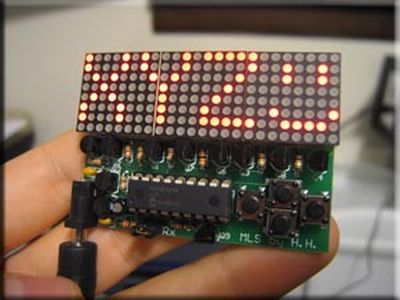Here you can find out how to drive an led matrix with 64 LEDs (8 rows by 8 columns – 8×8 display) or less e.g. 35 LEDs (7 rows by 5 columns – 5×7 dot matrix).
It uses persistence of vision to let you drive the 64 led matrix with only 10 microcontroller outputs!
Normally you would need 64 outputs for 64 LEDs but by using multiplexing and a helper chip you can get away with 10.
LED Display multiplexing simply means turning on one led for a short period of time and doing this repeatedly for each LED.
If you do this fast enough then your eye will not notice any flicker.
Note: The unit used in this project is simply an array of 64 LEDs.
The LEDs are no different to any other LEDs but it saves a huge amount of soldering as all the wiring has been done for you.
…Or you could wire it up yourself if you can’t get hold of the module.
If you wire it yourself you still only need 10 control wires (just wire you leds the same as shown in the module diagram).
A dot matrix led display is simply a grid of LEDs arranged for use by multiplexing.
Specification
| dot matrix led display driver | Red 8×8 LEDs |
Multiplexing
If you tried to drive 64 individual LEDs you would need 64 individual output pins (each led connected to a output pin on one side and ground on the other).
Obviously that is a tall order so the way round it is to use persistence of vision which is a way of describing how your eye works.
Your eye reacts slowly to changes in light intensity so that if a light is turned on and off quickly enough then it does not notice that the light is off. Basically your eye remembers a light pulse for a short time.
The approximate time is 20ms so if the light is turned on at a frequency >50Hz (1/20ms) then your eye will not notice any flicker at all.
Multiplexing uses this fact to reduce the number of pins needed to drive an LED display. You can do this by splitting the 64 led display into 8 rows and 8 columns which lets you drive it using 8 row outputs and 8 column outputs. In fact the 8×8 led matrix block used here has all the leds arranged in this way already.
For more detail: How to drive an led display matrix using PIC16F88

